$0.00
No products in the cart.
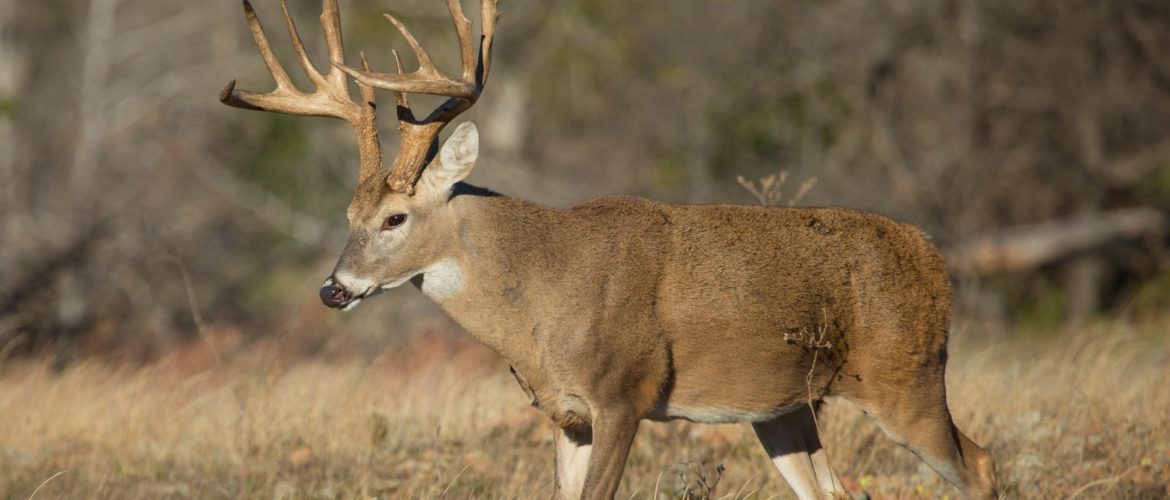
The white-tailed deer, also known as the whitetail or Virginia deer, is a medium-sized deer native to North America, Central America, Ecuador, and South America as far south as Peru and Bolivia. It’s been introduced to New Zealand (the Stewart Island herd, off the southern tip of the south Island and the Lake Wakitipu herd in the vicinity of the head of the lake), Cuba, Jamaica, Hispaniola, Puerto Rico, the Bahamas, the Lesser Antilles, and some countries in Europe, such as Finland, the Czech Republic, Romania, Serbia (where I have hunted to photograph them in the forests and clearings on what was previously Marshal Tito’s private hunting grounds along the banks of the Danube – they survive there in very limited numbers), Germany, France, and the Virgin Islands. In the Americas, it is the most widely distributed wild animal.
In North America Whitetail are widely distributed east of the Rocky Mountains as well as in southwestern Arizona and most of Mexico. They can also be found in mixed deciduous riparian corridors, river valley bottomlands, and lower foothills of the northern Rocky Mountain region from South Dakota west to eastern Washington and eastern Oregon and north to northeastern British Columbia and southern Yukon, including in the Montana valley and foothill grasslands. Texas is home to the largest population of whitetail of any U.S. state or Canadian province, with an estimated population of over four million. Notably high populations of white-tailed deer occur in the Edwards Plateau of Central Texas. Michigan, Minnesota, Iowa, Mississippi, Missouri, New Jersey, Illinois, Wisconsin, Maryland, New York, North Dakota, Ohio, Pennsylvania, and Indiana also boast high deer densities.
The conversion of land adjacent to the Canadian Rockies into agriculture combined with partial clear-cutting of coniferous trees (resulting in widespread deciduous vegetation) has been favourable to Whitetail deer and has extended their distribution as far north as Yukon. Populations of deer around the Great Lakes have also expanded their range northwards, due to conversion of land. The westernmost population of the species, known as the Columbian white-tailed deer, once was widespread in the mixed forests along the Willamette and Cowlitz River valleys of western Oregon and southwestern Washington, but today its numbers have been considerably reduced, and it is classified as near-threatened. This population is separated from other white-tailed deer populations.
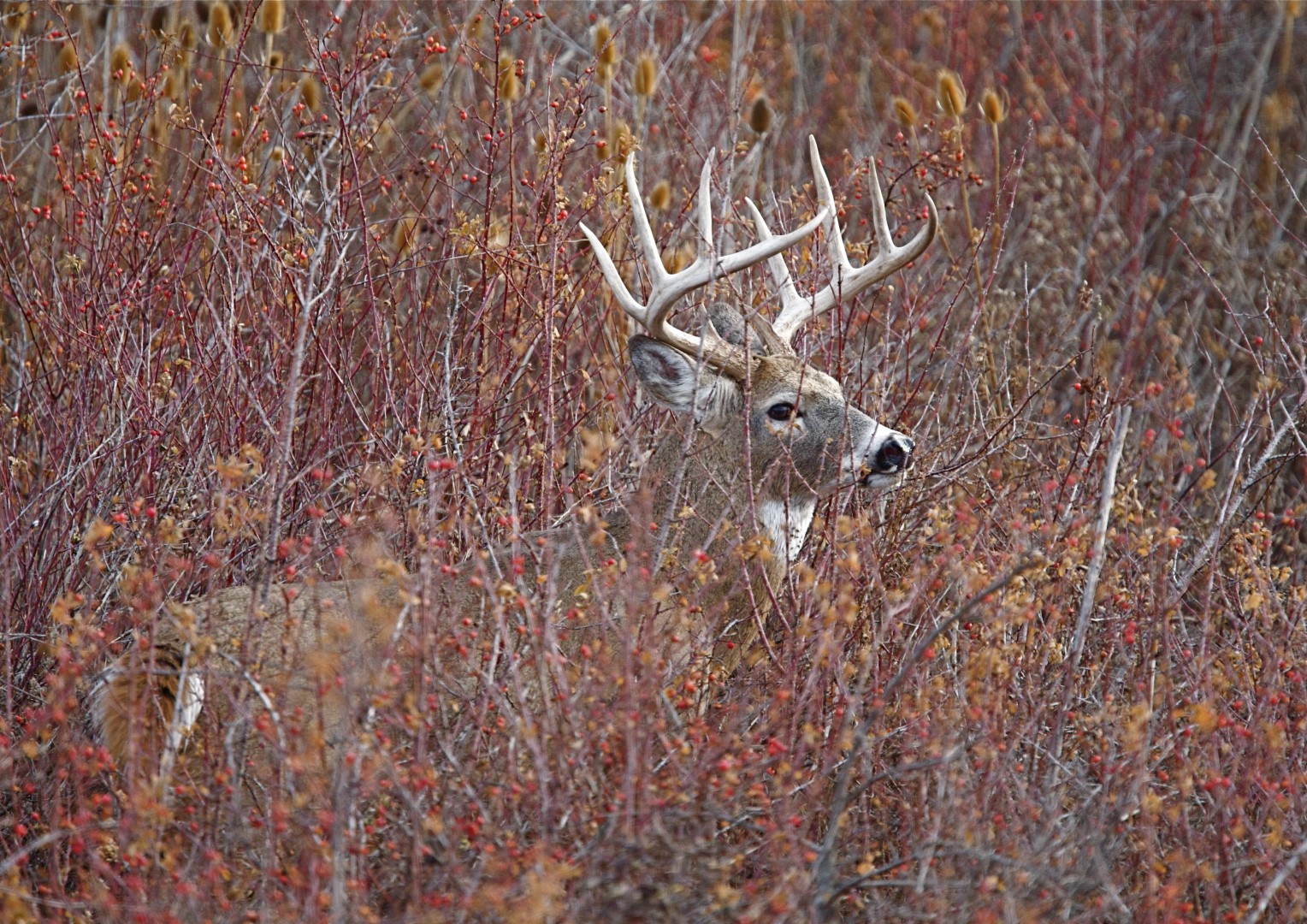
Some taxonomists have attempted to separate white-tailed deer into a host of subspecies, based largely on morphological (structure of organisms) differences. However genetic studies suggest fewer subspecies within the animal’s range, as compared to the 30 to 40 subspecies that some scientists have described in the last century (here is another prime example that deer are a product of their environment).
The Florida Key deer, O. v. clavium, and the Columbian white-tailed deer, O. v. leucurus, are both listed as endangered under the U.S. Endangered Species Act. In the United States, the Virginia white-tail, O. v. virginianus, is among the most widespread subspecies. The white-tailed deer species has tremendous genetic variation and is adaptable to several environments. Several local deer populations, especially in the southern states, are descended from white-tailed deer transplanted from various localities east of the Continental Divide. Some of these deer populations may have been from as far north as the Great Lakes region to as far west as Texas, yet are also quite at home in the Appalachian and Piedmont regions of the south. These deer, over time, have intermixed with the local indigenous deer (O. v. virginianus and/or O. v. macrourus) populations.
The scientific name of white-tailed deer is Odocoileus virginianus (Zimmerman) There are 38 subspecies in the world. Seventeen of these occur in North America, ordered alphabetically:
North America
• O. v. borealis – northern white-tailed deer (the largest and darkest of the white-tailed deer)
• O. v. carminis – Carmen Mountains white-tailed deer (Texas-Mexico border)
• O. v. clavium – Key deer or Florida Keys white-tailed deer (the smallest North American subspecies, found in the lower Florida Keys; an example of insular dwarfism)
• O. v. couesi – Coues’ white-tailed deer, Arizona white-tailed deer, or fantail deer
• O. v. dacotensis – Dakota white-tailed deer or northern plains white-tailed deer (most northerly distribution, rivals the northern white-tailed deer in size)
• O. v. hiltonensis – Hilton Head Island white-tailed deer
• O. v. leucurus – Columbian white-tailed deer (Oregon and western coastal area)
• O. v. macrourus – Kansas white-tailed deer
• O. v. mcilhennyi – Avery Island white-tailed deer
• O. v. nigribarbis – Blackbeard Island white-tailed deer
• O. v. ochrourus – northwestern white-tailed deer or northern Rocky Mountains white-tailed deer
• O. v. osceola – Florida coastal white-tailed deer
• O. v. seminolus – Florida white-tailed deer
• O. v. taurinsulae – Bulls Island white-tailed deer (Bulls Island, South Carolina)
• O. v. texanus – Texas white-tailed deer
• O. v. venatorius – Hunting Island white-tailed deer (Hunting Island, South Carolina)
• O. v. virginianus – Virginia white-tailed deer or southern white-tailed deer
South America
• O. v. cariacou – (French Guiana and northern Brazil)
• O. v. curassavicus – (Curaçao)
• O. v. goudotii – (Colombia (Andes) and western Venezuela)
• O. v. gymnotis – South American white-tailed deer (northern half of Venezuela, including Venezuela’s Llanos region)
• O. v. margaritae – (Margarita Island)
• O. v. nemoralis – (Central America, round the Gulf of Mexico to Surinam in South America; further restricted from Honduras to Panama)
• O. v. peruvianus – South American white-tailed deer or Andean white-tailed deer (most southerly distribution in Peru and possibly Bolivia)
• O. v. tropicalis – Peru and Ecuador (possibly Colombia)
• O. v. ustus – Ecuador (possibly southern Colombia and northern Peru)
Central and South America have a complex number of white-tailed deer subspecies that range from Guatemala to as far south as Peru. This list of subspecies of deer is more exhaustive than the list of North American subspecies, and the number of subspecies is also questionable. The white-tailed deer populations in these areas are difficult to study, due to overhunting in many parts and a lack of protection. Some areas no longer carry deer, so assessing the genetic difference of these animals is difficult.
Safari Club International (SCI) in their record book for recording antler size have classed North American Whitetail into the following categories:
Northwestern White-Tailed Deer
Northeastern White-Tailed Deer
Southeastern White-Tailed Deer
Texas White-Tailed Deer
Coues White-Tailed Deer
Tropical White-Tailed Deer
In addition to this SCI compile records for South American White-Tailed deer that largely exist across the most northerly countries of that continent.
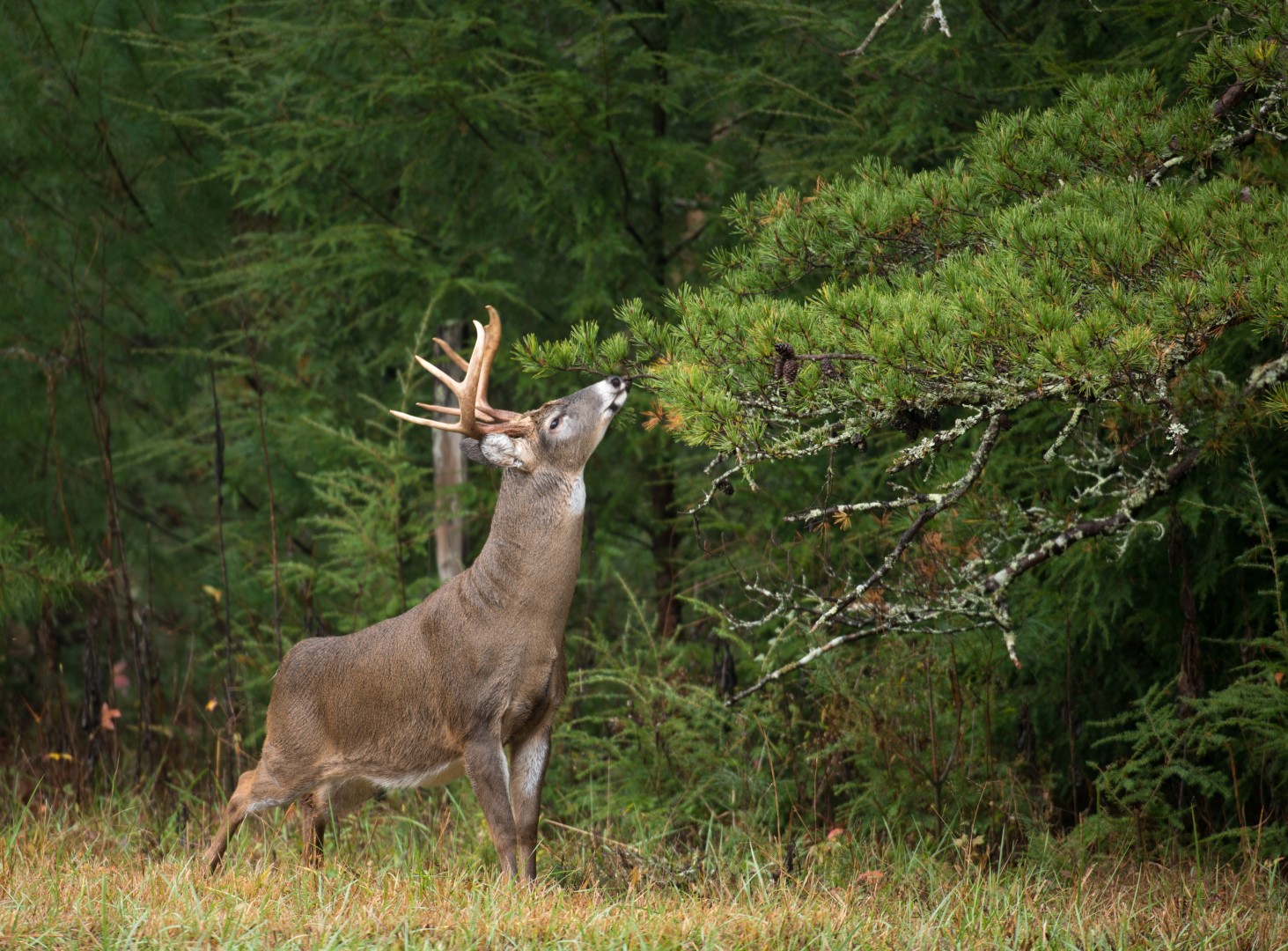
The white-tailed deer is highly variable in size, generally following both Allen’s rule and Bergmann’s rule that the average size is larger farther away from the Equator. North American male deer (known as a buck) usually weigh 68 to 136 kg (150 to 300 lb), but mature bucks over 180 kg (400 lb) have been recorded in the northernmost reaches of their native range, specifically, Minnesota and Ontario. In 1926, Carl J. Lenander, Jr., took a white-tailed buck near Tofte, MN, that weighed 183 kg (403 lb) after it was field-dressed (internal organs and blood removed) and was estimated at 232 kg (511 lb) when alive. The female (doe) in North America usually weighs from 40 to 90 kg (88 to 198 lb). White-tailed deer from the tropics and the Florida Keys are markedly smaller-bodied than temperate populations, averaging 35 to 50 kg (77 to 110 lb), with an occasional adult female as small as 25 kg (55 lb). White-tailed deer from the Andes are larger than other tropical deer of this species, and have thick, slightly woolly looking fur. Length ranges from 95 to 220 cm (37 to 87 in), including a tail of 10 to 37 cm (3.9 to 14.6 in), and the shoulder height is 53 to 120 cm (21 to 47 in). Including all races, the average summer weight of adult males is 68 kg (150 lb) and is 45.3 kg (100 lb) in adult females.
Deer have dichromatic (two-color) vision with blue and yellow primaries; humans normally have trichromatic vision. Thus, deer poorly distinguish the oranges and reds that stand out so well to humans. This makes it very convenient for hunters to wear deer-hunter orange for safety.
Males regrow their antlers annually. Bucks without branching antlers like in most deer species are often termed “spikehorn”, “spiked bucks”, “spike bucks”, or simply “spikes/spikers”. The spikes vary in length. Length and branching of antlers are determined by nutrition, age, and genetics. Rack growth tends to be very important from late spring until about a month before velvet sheds. Although antler size typically increases with age, antler characteristics (e.g., number of points, length, or thickness of the antlers) are not good indicators of buck age, in general, because antler development is influenced by the local environment. The individual deer’s nutritional needs for antler growth is dependent on the diet of the deer, particularly protein intake.
Whitetail begin to grow their antlers in late spring, covered with what is known as velvet. Bucks either have a typical or atypical antler arrangement. Typical antlers are symmetrical and the points grow straight up off the main beam (typical classification for trophy records). Atypical antlers are asymmetrical and the points may project at any angle from the main beam (non-typical classification for trophy records). These descriptions are not the only limitations for typical and atypical antler arrangement. The Boone and Crockett or Pope and Young scoring systems also define relative degrees of typicality and atypicality by procedures to measure what proportion of the antlers is asymmetrical. Therefore, bucks with only slight asymmetry are scored as “typical”. A buck’s inside spread can be from 3 to 25 in (8–64 cm). Bucks shed their antlers when all females have been bred, from late December to February.
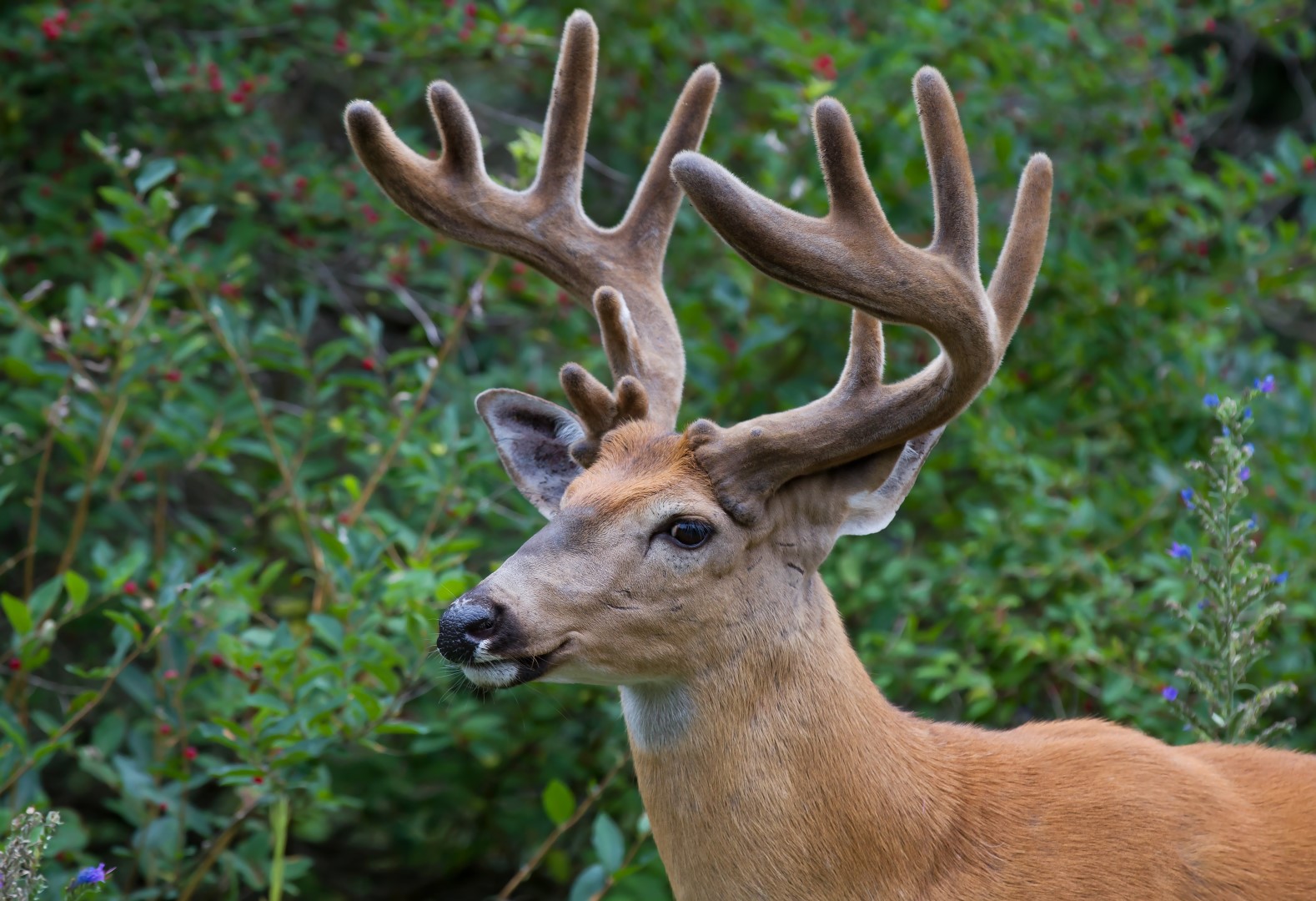
White-tailed deer are generalists and can adapt to a wide variety of habitats. The largest deer occur in the temperate regions of North America. The northern white-tailed deer (O. v. borealis), Dakota white-tailed deer (O. v. dacotensis), and northwest white-tailed deer (O. v. ochrourus) are some of the largest animals, with large antlers. The smallest deer occur in the Florida Keys and in partially wooded lowlands in the neotropics.
Although generally thought of as forest animals depending on relatively small openings and edges, white-tailed deer can equally adapt themselves to life in more open prairie, savannah woodlands, and sage communities as in the Southwestern United States and northern Mexico. These savannah-adapted deer have relatively large antlers in proportion to their body size and large tails. Also, a noticeable difference exists in size between male and female deer of the savannahs. The Texas white-tailed deer (O. v. texanus), of the prairies and oak savannahs of Texas and parts of Mexico, are the largest savannah-adapted deer in the Southwest, with impressive antlers that might rival deer found in Canada and the northern United States. Populations of Arizona (O. v. couesi) and Carmen Mountains (O. v. carminis) white-tailed deer inhabit montane mixed oak and pine woodland communities. The Arizona and Carmen Mountains deer are smaller, but may also have impressive antlers in comparison to their size. The white-tailed deer of the Llanos region of Colombia and Venezuela (O. v. apurensis and O. v. gymnotis) have antler dimensions similar to the Arizona white-tailed deer.
In some western regions of North America, the white-tailed deer range overlaps with those of the mule deer. White-tail incursions in the Trans-Pecos region of Texas have resulted in some hybrids.
Central American white-tailed deer prefer tropical and subtropical dry broadleaf forests, seasonal mixed deciduous forests, savannah, and adjacent wetland habitats over dense tropical and subtropical moist broadleaf forests. South American subspecies of white-tailed deer live in two types of environments. The first type, similar to the Central American deer, consists of savannas, dry deciduous forests, and riparian corridors that cover much of Venezuela and eastern Colombia. The other type is the higher elevation mountain grassland/mixed forest ecozones in the Andes Mountains, from Venezuela to Peru. The Andean white-tailed deer seem to retain grey coats due to the colder weather at high altitudes, whereas the lowland savannah forms retain the reddish brown coats. South American white-tailed deer, like those in Central America, also generally avoid dense moist broadleaf forests.
Whitetail deer were imported into Finland from Minnesota in 1934-35 where they are presently (2020) reported to number approximately 109,000. They adapted very well to the new Finnish environment, characterized by a large number of small lakes and woods of birch, poplar, beech, pine and fir trees. The deer have recently begun spreading through northern Scandinavia and southern Karelia, competing with, and sometimes displacing, native species. From Finland whitetail deer were introduced into the current Czech Republic, Slovakia, Serbia and Croatia. In the Czech Republic they escaped a high fenced area and are now free range. In this locality not far from Prague they are estimated to number approximately 700 individuals.
White-tailed deer eat large amounts of food, commonly eating legumes and foraging on other plants, including shoots, leaves, cacti (in deserts), prairie forbs, and grasses. They also eat acorns, fruit, and corn. Their special stomachs allow them to eat unusual items such as mushrooms and poison ivy. Their diets vary by season according to availability of food sources. They also eat hay, grass, white clover, and other foods they can find in a farmyard. Though almost entirely herbivorous, white-tailed deer have been known to opportunistically feed on nesting songbirds, field mice, fish and birds trapped in mist nets, if the need arises.
The white-tailed deer is a ruminant, which means it has a four-chambered stomach. Each chamber has a different and specific function that allows the deer to eat a variety of different foods, digesting it at a later time in a safe area of cover. The stomach hosts a complex set of microbes that change as the deer’s diet fluctuates through the seasons. If the microbes that are necessary for digestion of a particular food (e.g., hay) are absent, it will not be digested.
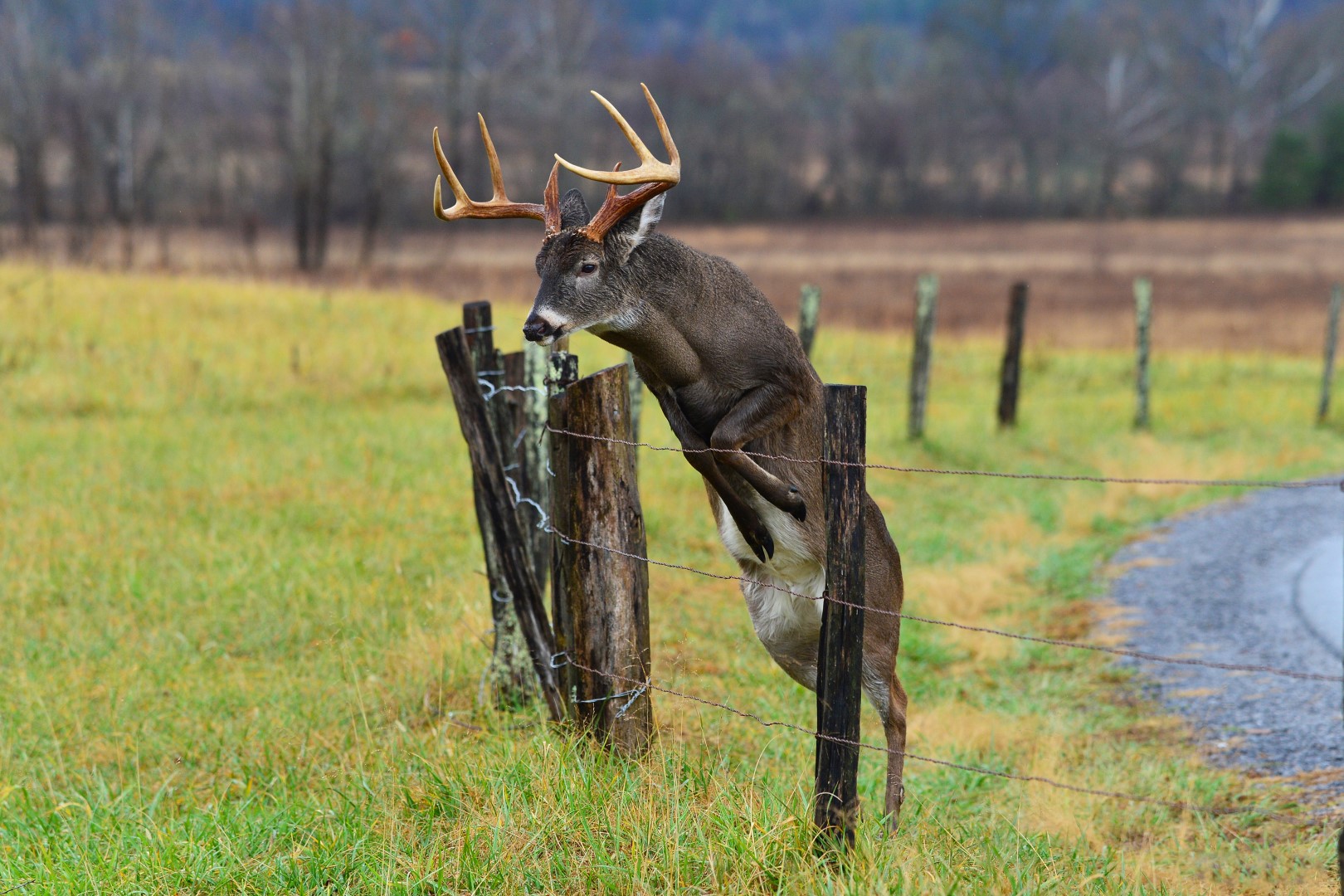
There are several natural predators of white-tailed deer with wolves, cougars, American alligators, jaguars (in the American southwest, Mexico, and Central and South America) and humans being the most effective natural predators. Aside from humans, these predators frequently pick out easily caught young or infirm deer but can and do take healthy adults of any size. Bobcats, Canada lynx, bears, wolverines, and packs of coyotes usually prey mainly on fawns. Bears may sometimes attack adult deer, while lynxes, coyotes, and wolverines are most likely to take adult deer when the ungulates are weakened by harsh winter weather.
White-tailed deer typically respond to the presence of potential predators by breathing very heavily (also called blowing) and fleeing. When they blow, the sound alerts other deer in the area. As they run, the flash of their white tails warns other deer. This especially serves to warn fawns when their mother is alarmed.
The deer of Virginia can run faster than their predators and have been recorded at speeds of 47 miles (76 km) per hour; this ranks them amongst the fastest of all deer species, alongside the Eurasian Roe deer. They can also jump 9 ft (2.7 m) high and up to 30 ft (9.1 m) forward. When shot at, the white-tailed deer will run at high speeds with its tail down. If frightened, the deer will hop in a zig-zag with its tail straight up. If the deer feels extremely threatened it has been known to defend its self against predators and humans by using its antlers, head and hooves. The whitetail is a sprinter however and uses obstructions, its agility and speed to escape. Its weakness is its lack of endurance and this is how packs of coyotes and wolves that remain on the hunt prey upon them.
The whitetail is one of the New World deer species, yet believed to be the oldest unchanging deer species, estimated to have remained the same for approximately 3.5 million years (the Muntjac and Musk deer being Old World deer and estimated to arrived around 30 to 40 million years ago). The whitetail is an incredibly adaptable deer and possibly only rivalled or outdone by the highly adaptable European Red deer. I’ve been fortunate to be able to successfully hunt Whitetail from the smallest Tropical Whitetail on the boarder of Mexico and U.S to the larger varieties in the northern U.S such as Wisconsin as well as completing multiple hunts in various habitats and altitudes in New Zealand. It’s my belief that the whitetail is one of the most naturally alert deer species. It has an amazing talent of slipping away and disappearing – leaving a hunter questioning his skill-level and trying to determine where he went wrong!
An amazing variety of hunts are available for Whitetail deer with one to suit everyone’s budget.